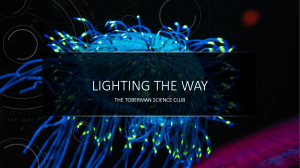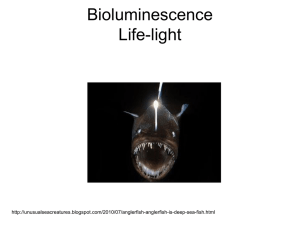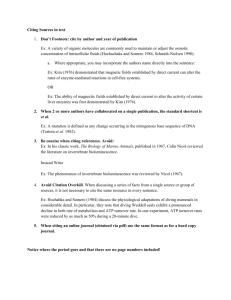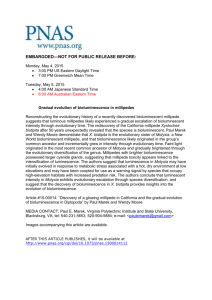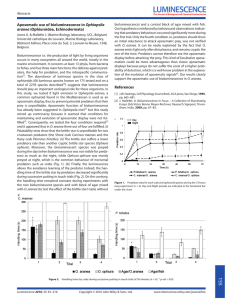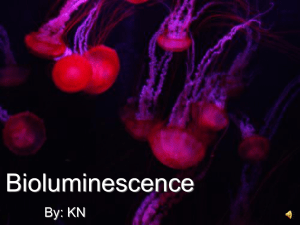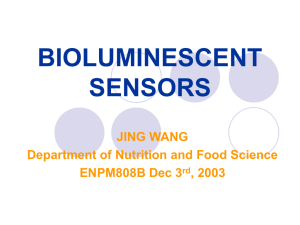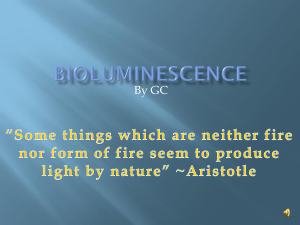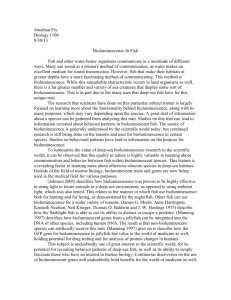Bioluminescence
advertisement
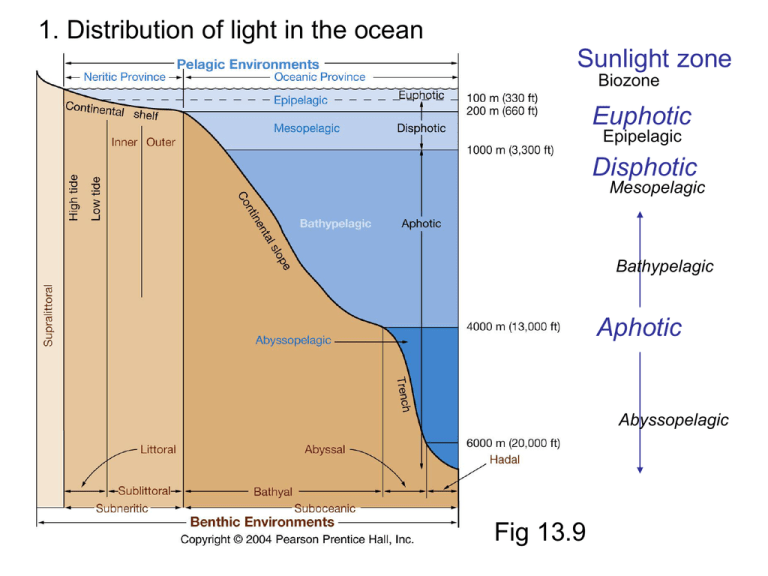
1. Distribution of light in the ocean Sunlight zone Biozone Euphotic Epipelagic Disphotic Mesopelagic Bathypelagic Aphotic Abyssopelagic Fig 13.9 Hatchet fish 2. Adaptations to the deep sea •Bioluminescence •Mating •Feeding Gulper eel Female angler fish Fig 15-14 Bioluminescence A. Bioluminescence a) What? Definition: The emission of ecologically functional light by living organisms Light is produced by a chemical reaction within the organism – no ‘input’ of energy Note: phosphorescence – emission of light with input of energy fluorescence – input of energy to excite a molecule giving off light b) Where? • Marine bacteria • Dinoflagellates • All major phyla c) How bioluminescence works “optimizer” Photon of light enzyme substrate Core of the reaction • has strong antioxidative properties • detoxifies tissues by taking up oxygen free radicals • usually brought into the system by diet or synthesis internally d) Likely originated to detoxify oxygen derivatives Bioluminescence in different organisms http://www.lifesci.ucsb.edu/~biolum/ chem/detail1.html e) Examples of bioluminescent organisms & their molecules: 1. Coelenterazine: most ‘popular’ of the luciferins (substrate); known in cnidarians, molluscs, chaetognaths, fish. • • • • • Can act alone or with another enzyme Often acts together with aequorin Chemistry: Imidazolopyrazinone Found in all tissues of the animal Highest concentration in digestive gland, liver hepatopancreas, organs with high levels of oxidative reactions 2. Aequorin: a ‘luciferase’ (enzyme) that requires calcium Aequorin is called a ‘photoprotein’ because it requires calcium to work with a luciferin (such as coelenterazine) O2 Apoaequorin (enzyme) Coelenterazine (substrate) Ca 2+ AequorinCoelenterazine (excitable intermediate) Apoaequorin photon Colenteramide And CO2 3. Bacterial luciferin: most often harnessed by other animals and used for light emission (e.g. fish, squid) Vibrio: a marine bacterium (free-living) that is an endosymbiont in squid Luminescence is dependent on cell density (reduced riboflavin phosphate FMNH2 ) Aequoria victoria f) When is bioluminescence used? (1) lure Angler Fish (2) Burglar Alarm: startling predators of your predator Cephalopod predation is facilitated by dinoflagellate luminescence Pre-attack ‘Positioning’ ‘Seizure’ Ghost shrimp squid (Fleisher and Case: Biol. Bull. 1995 189:263-271) (3) Alarm/warning of other colonies: e.g. Pyrosomes Stops feeding and swimming current http://divefilm.com/dive_films/indexC.html More examples: 4) Krill – use bioluminescence for attracting mates 5) Bacterial endosymbiont in the squid Euprymna scolopes E. scolopes burries in the sand during the day and forages at night. Uses the bioluminescence produced by the Vibrio to counter-shade it against the moonlight so that prey won’t see its shadow. Hatchling squid pick up the bacteria and develop a special pouch for them B. Adaptations - Mating Parasitic male C. Adaptations - feeding Chauliodus sloani Large teeth Hinged jaw Chiasmodon niger Vast stomach! Fig 15-15 Chauliodus sloani Gulper eel Carnivorous tunicate Atrial siphon Oral siphon (mouth) Carnivorous sponge: Asbestopluma From Barkley Sound Amphipod crustacean Asbesopluma hypogea – Carnivorous sponge from the Mediterranean (Marseille, France)
